Form, Form, Riflemen Form
Tennyson
Ready be ready against the Storm
Riflemen, Riflemen, Riflemen form
Introduction
There are stories and myths surrounding the Lindow Landscape and these include a Crimean War era rifle range and rifle volunteers. This article has been prepared to look into the stories and produce a historical account which can inform possible interpretation for Wilmslow Town Council’s Lindow Partnership Project and inform our Society’s Town History Tours.
If you have any information or evidence about Wilmslow’s volunteers, these please contact the Wilmslow Historical Society via wilmslowhistoricalsociety@gmail.com or 01625 536909.
This is not to say the myths are not interesting in themselves including veterans from war (but not the Crimean) returning from some conflict with disease and taking up residence in the butts and living separately from the Wilmslow Community.
Tennyson’s poem is included in Appendix 7,
Thank you.
Cllr Jon Kelly.
Crimean War
The Crimean War 1854-56 was fought between an alliance of Britain, France and Turkey against Russia symbolised by military and logistical incompetence alongside bravery and endurance of its soldiers. Poor medical care and conditions lead to a scandal and work by Florence Nightingale and Mary Seacole to improve things.
After the Crimean War, with fears of a French invasion, the Volunteer Force was a citizen army of part-time rifle, artillery and engineer corps, created as a popular movement throughout the British Empire.
Rifle volunteers up and down the country in 1859 had already begun to form and the Government at last took charge of the developing situation. On 12 May 1859 the Secretary of State for War, Jonathan Peel issued a circular letter to county lieutenants authorising the formation of the volunteer rifle corps. In 1859 the Volunteer Corps were supposed to receive 25 Enfield Rifles for every 100 enrolled Volunteer on condition that the corps provide a secure armoury, a safe range, adopt approved rules and be subject to military inspection.
A Rifle Volunteer Grounds Act 1860 gave Volunteer Corps the power to purchase or acquire by grant land for rifle practice and an 1861 Volunteer Exemption from Toll Act relating to ‘turnpikes’ was passed. The Volunteer Bill 1863 consolidated earlier Acts relating to the Volunteer force it dealt with organisation, military service, discipline, property, acquisition of land for ranges, exemption from certain other Acts, miscellaneous
The rifle corps in East Cheshire was raised in 1859. In Chester there is a printed report and poster for a public meeting on 28 November 1859 and a newspaper account of a meeting of members of the Chester Volunteer Rifle Corps for the adoption of rules and regulations. In Wilmslow and Alderley Edge, the 27th Corps in Wilmslow was formed by Captain Edward Hyde Greg on the 5th March 1860 as part of the 5th Administrative Battalion (please see appendixes 2 and 7). Volunteers and Regular army had originally been entirely separate concepts and structures. The 5th Battalion became the 5th Cheshire Rifle Volunteer Corps in 1880 and the local “Rifle Corps becoming “Companies” identified by a capital letter instead of a number. 5th Corps first linked up with the Cheshire Regiment in 1880/1. It was not to 1887 when it was designated the 5th Volunteer Battalion and firmly integrated into the Cheshire Regiment.

Captain Edward Hyde Greg looking splendid in his uniform
Photo by kind permission of National Trust, Quarry Bank Mill.
Captain Hyde’s notebook from 1861 to 1866 including muster lists with names survives in the National Trust Quarry Bank Archive.

Photo by kind permission of National Trust, Quarry Bank Mill.
Among the conditions attached to the formation of these Corps were:
‘That a corps be formed under officers bearing the commission of the Lord Lieutenant and that its formation be recommended by him: that its members undertake to provide their own arms and equipment and to defray all expenses attending to the Corps except in the event of it being assembled for actual service.’
‘The uniform and equipment may be settled by the members, subject to the Lord Lieutenant’s approval, but arms though provided at the expense of members must be furnished under the superintendence of the war Department in order to secure a uniformity of gauge’.
In 1871 Macclesfield the Drill Hall opened as the headquarters of the 8th Cheshire Rifle Volunteers. In 1881 the regular Cheshire Regiment had formed from the 22nd (Cheshire) Regiment of Foot integrating two militia battalions and the five Volunteer (administrative) battalions. In 1883 the volunteers evolved to become the 5th Volunteer Battalion, the Cheshire Regiment in 1887. Captain Greg had served as 27th Company officer in charge until resigning his commission in January 1881 continuing as 5th Battalion President of the Mess Committee.
The local attitudes to the corps and other competing distractions are wonderfully illustrated in a letter to the Volunteer Service Gazette of 20 November 1875, whereby “the sons of the well to do look down on us with something akin to pity if not contempt… a feeling which is universal.” The article is reproduced in Appendix 1.
Life in the Corps
Although the non-military business of the volunteer corps was conducted by a committee of members, these corps were subject to the overall supervision of the War Office in London and the local lord lieutenant. The emphasis was on locally raised units encouraging the social side with dances, shooting competitions and other events all adding to the camaraderie and cohesion of the units. By December 1884 the unit had 100 Volunteers.
There is a report from the Wilmslow Advertiser of a local shooting match against 19th Cheshire Corp of Stockport over 200-, 400- and 500-yards dated 14th October 1865.
There are newspaper reports in the Wilmslow Advertiser. The edition from 8th September 1877 records on competition at Lindow after which the company mustered at Fulshaw Cross
and with Drum and Fife band marched to Warham’s Hotel (Railway Hotel) for an excellent dinner. Away matches are recorded from at Stockport, Bowden and Danes Moss, Macclesfield.
The range apparently closed during the winter with bayonet drills then taking place on Wednesdays (Advertiser 18/1/1875) and Assault-at-Arms exercises (Advertiser 30th October 1875).
On 8th October 1886 The Wilmslow and Alderley Advertiser recorded:
‘THE CHALLENGE HAS NOT BEEN ACCEPTED.
This year the secretary of the shooting committee of the Wilmslow Volunteers has been unable to get any teams from other corps to accept a challenge to shoot the local team, and this being so it was decided amongst the local men to have a match amongst themselves. This took place on Saturday afternoon at the Lindow shooting range, the teams being captained by Captains Cobbett and Williams. The result proved a victory for the team of the former gentleman by over 100 points. After the contest the rival teams adjourned to the headquarters of the corps, the Railway Hotel where they sat down to a repast of a recherché character, and subsequently several of the company contributed songs and recitations, a pleasant evening being spent.’ [A.&.W. A., 08.10.1886]
Drills and Camps
Regular practice produced marksmen and sharpshooters. There were regular shooting competition between companies, indeed Captain Greg had won a competition in 1860 at Altcar shooting over 800, 900 and 1000 yards. The magnificent trophy he won became known as the Greg Cup and is in the Cheshire Regiment Museum in Chester.
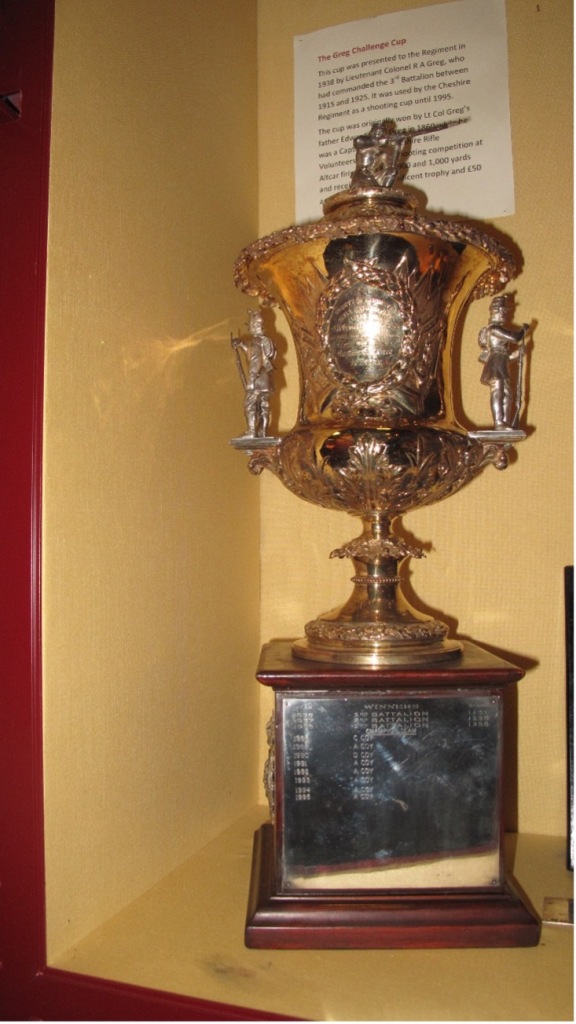
photo by kind permission of the Cheshire Military Museum Chester.
The Corps attended Battalion Drills, Field Days, shooting competitions and there was an annual camp at Somerford Park midway between Congleton and Holmes Chapel in Cheshire. An 1872 report of one ” Annual Drill and Sham Fight” said “This was the last of these parades; they were a source of great inconvenience and vast expense, and the benefit derived from them was very trifling. In addition to a heavy charge for railway fares, the men’s rations cost from £40 to £50; and for this, two hours’ hurried drill was obtained. “
The 1878 Battalion annual shooting competition comprised seven Shots each, at 200, 500, and 600 yards. “Snider Rifles only. Government pattern, and regularly used on parade, are allowed. Minimum pull of 6 lbs. Each man to provide his own Government Ammunition.”
Volunteers could shoot for the annual Battalion Challenge Cup which if the same Volunteer won for two consecutive years, or three times altogether, it became his private property. The Sergeant-Instructors’ Match carried a first Prize, £3 given by Lieut.-Colonel Sir Charles Shakerley, Bart and the Second prize was £2 from the Battalion Fund.
An officers’ Match for the Gold Challenge Medal, presented by Sir Charles Shakerley, took place at Crewe, on Saturday, September 28th, 1878, at 3-45 p.m. “All Officers of the Battalion are invited to compete. Seven Shots each, at 400, 500, and 600 yards, Officers to provide their own Ammunition, any position allowed (prone, kneeling or standing).”
The Range at Lindow
Part V of Volunteer Act 1863 dealt with the process of acquiring land for shooting ranges. Apart from the corps taking ownership of the land, a municipal corporation or private company could grant a licence to the volunteers to use their land for the purpose. Justices of the peace were given the power to close rights of way adjacent to ranges.
Both the Lindow ranges 600 and 900 yards are likely to have been built at the same time in1860/1.
1862, ‘27th Cheshire (Wilmslow) R.V.C. – This range of 1000 yards lies nearly north and south. It is in a common (Linden) [sic]. The butt is of sand and turf, 30 feet high and 70 long, at top there are 6 targets, 6 feet by 2 feet each. The range on one side is 600 yards, and on the reverse side 1000 yards. The cost was 200 pounds. It is a mile and a half from Aldersley Edge [sic], and Wilmslow equi-distant. The Armoury is on the ground, with a person in charge. The Serjeant Instructor attends daily during the shooting season. The Company (under 60) have fired this season about 10,000 rounds of ammunition [Blanch, 1862].
By 1872 it appears on the Crown Ordnance Survey Map (published 1887) but local deeds which show it suggest at Lindow the land remains in private land, in this case belonging to the Earl of Stamford.
There was a double range of 600 yards and another of 1000 yds both backed by double facing butts were mantles (bullet proof shelters or screens) and a tower accessed from Battery Lane. The butt was an earth bank behind the targets made of sand and turf thirty feet high and seventy feet long to stop thebullets.
Lindow rifle range was established at a cost of £200 for the volunteers and by 1872 it appears on the Crown Ordnance Survey Map but local deeds which show it suggest at Lindow the land remains in private land, in this case belonging to the Earl of Stamford.

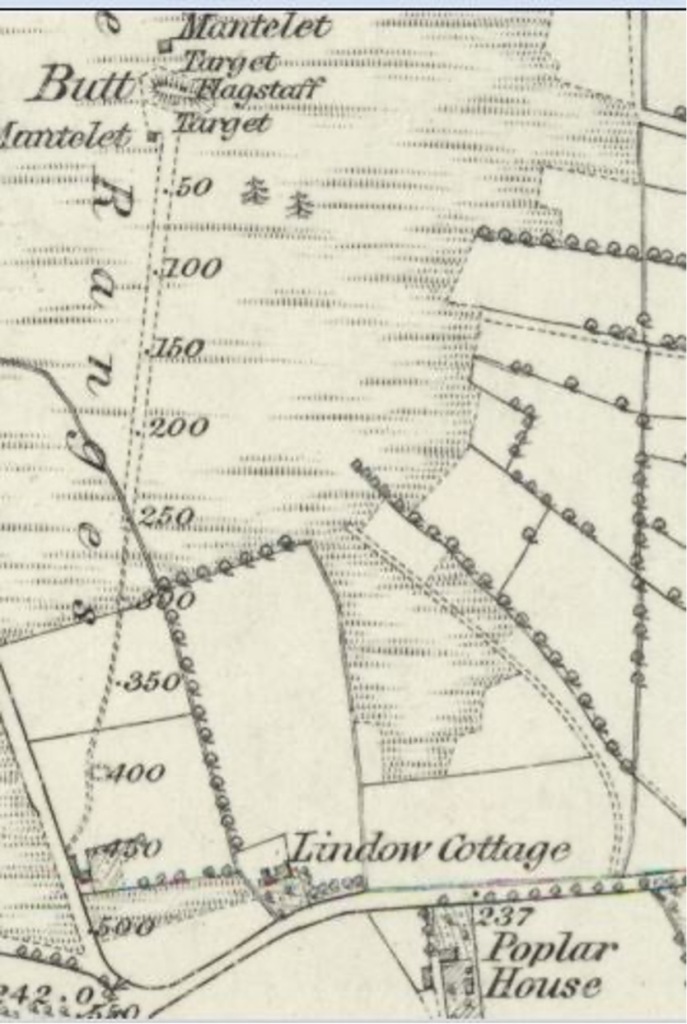
On the lower map Moor Lane runs across the bottom and Battery Lane (now Rotherwood Road) runs from it towards the top.
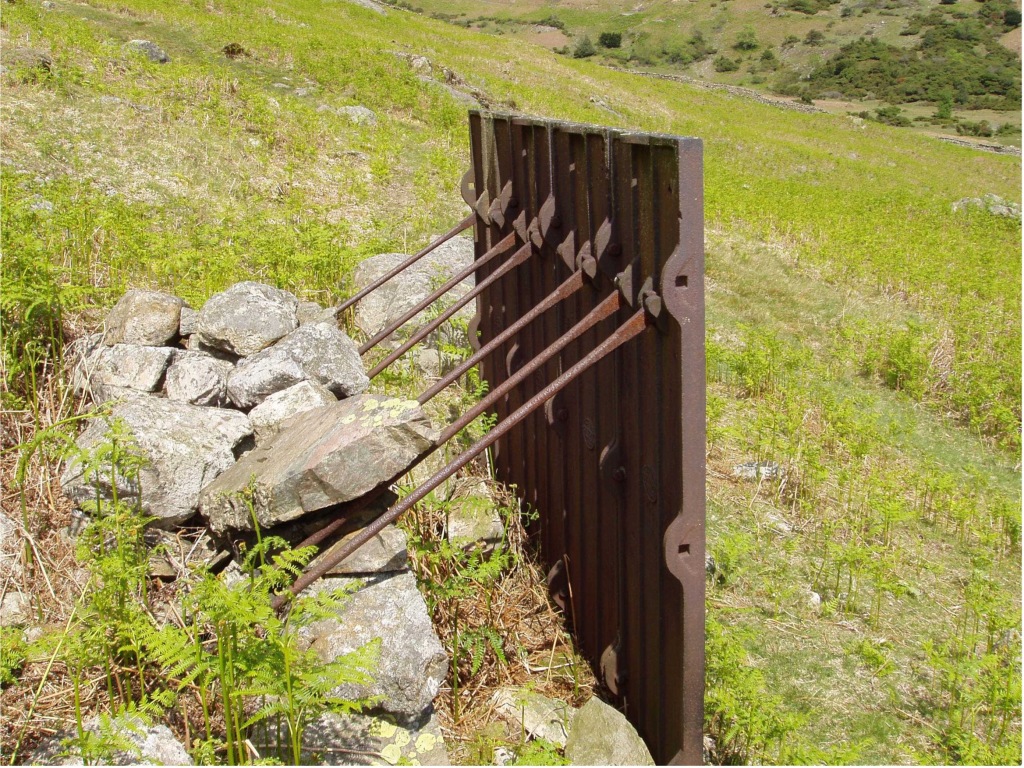
Here is a picture of some original metal targets still in situ a former range in the Lake District near Grasmere.
Generally, all ranges used iron target for military musketry training and classification shooting originally supplied from Woolwich military foundries. Iron target plates were 6ft tall and 2 ft wide with a pre- cast or incised grid of 6in squares and concentric circles to mark out the scoring rings and bull’s eye.
The targets were usually standing in an almost vertical position on a stone platform, intended to prevent them from sinking into the ground. They were held up in that position by support rods, resembling pitchforks, which were simply hooked into the back of a target and rammed into the ground. Each single plate weighed between 150-250 kg and accidentally falling targets caused many injuries and deaths among markers and civilians.
The marker would whitewash the whole target and paint the bull’s eye and scoring rings only in black. The effect of a bullet hitting the target was visible, as the lead bullet, while disintegrating into splinters or splash, would leave a distinct grey lead smudge on the target. Later targets were made out of canvas.
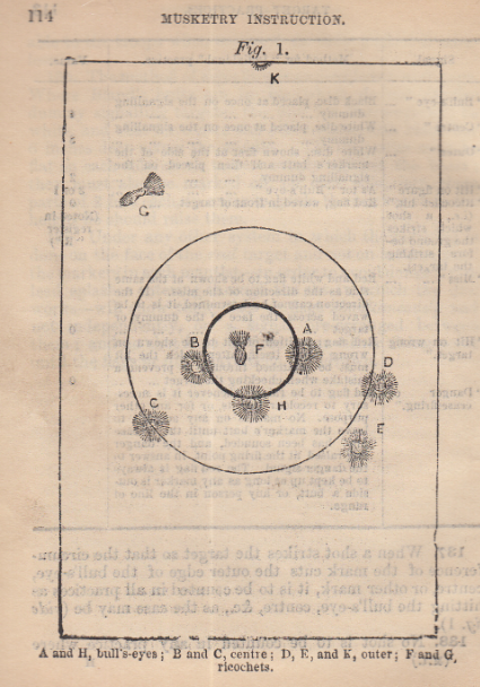
Photograph and diagram kindly provided by Bill Flentje
There are original targets surviving in a remote location on Blea Moss, Great Langdale and a ‘stylised’ target face with such smudge marks, as illustrated in the 1887 Musketry Regulations.
The soldiers tending the targets sheltered behind the mantelets during firing. Accounts report an armoury being located on the ground with a person in charge (possibly near the 400-yard firing point on the map above), a sergeant instructor attending daily during the shooting season. At that time Lindow Moss was clear of trees and there were long views right across. Soldiers in the butts would communicate to the firing points by flags. The firing point would use a bugle. A red flag flying from the flagpole showed firing was underway. In 1862 there were apparently ten two-feet targets on the North side and six six-foot by two foot presumably on the South side range.
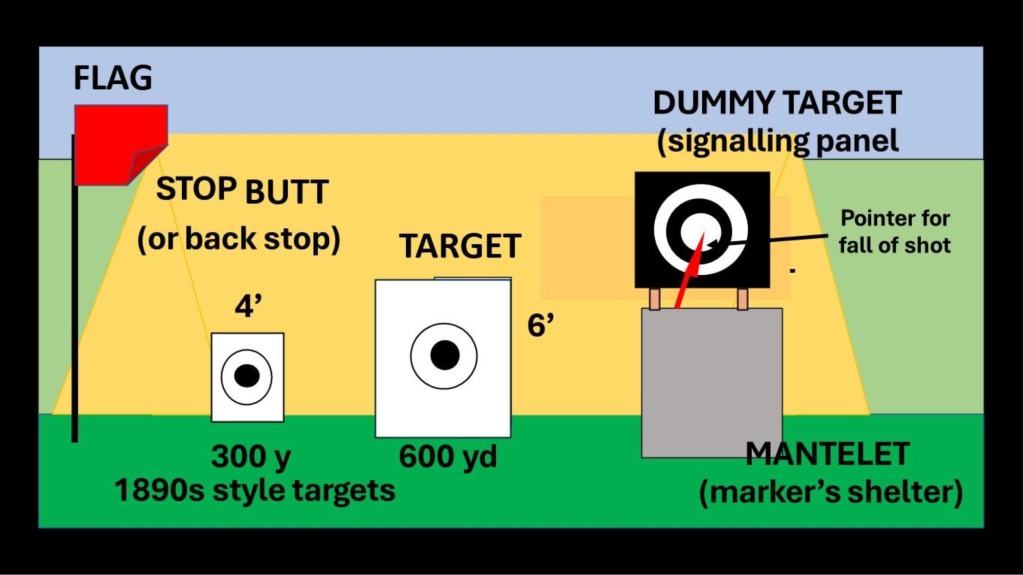
A diagrammatic view of the butts from a firing point.
An account says the Stop Butt was 25 yards wide and 15 yards high. The mantlet was constructed of stone or iron (not wood), often reinforced by an earth bank. (Please see appendix 4.) To eliminate the danger from bullet splinters, the target was positioned about 16 yards beyond the Mantlet.

A photograph from the 1890s of a butt in a hillside at Hastings showing full 600-yard targets, smaller 300-yard targets and mantelets with signalling panels above. (See Appendix 5).
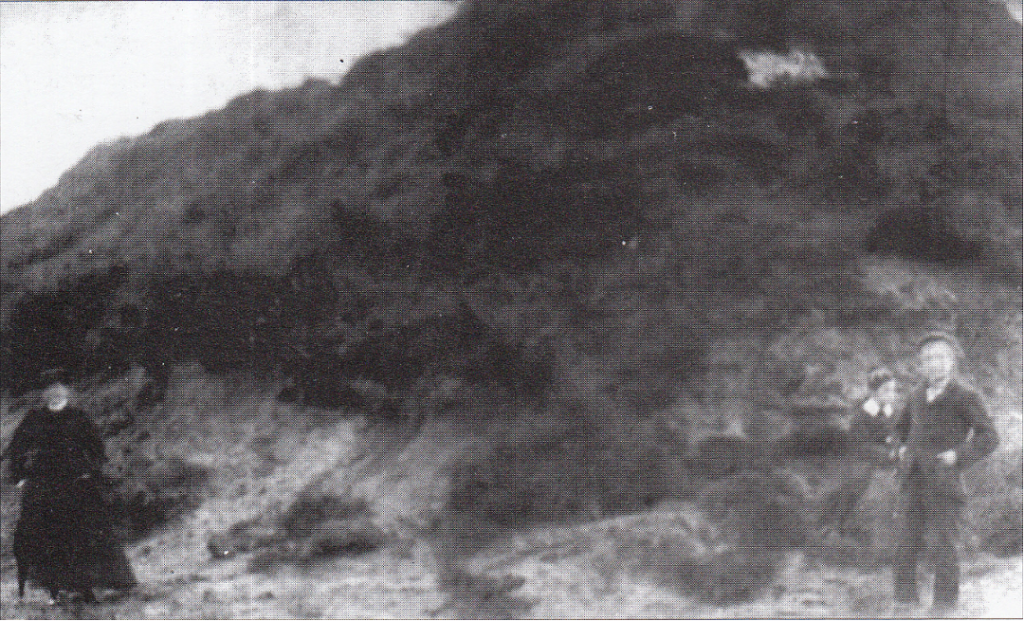
A photo of the Lindow butts earth bank circa 1900.
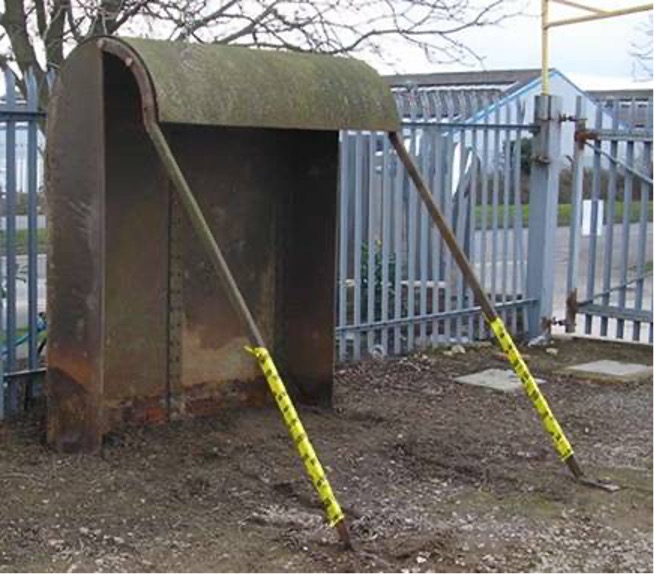
A surviving metal mantelet elsewhere.
Photograph kindly provided by Bill Flentje
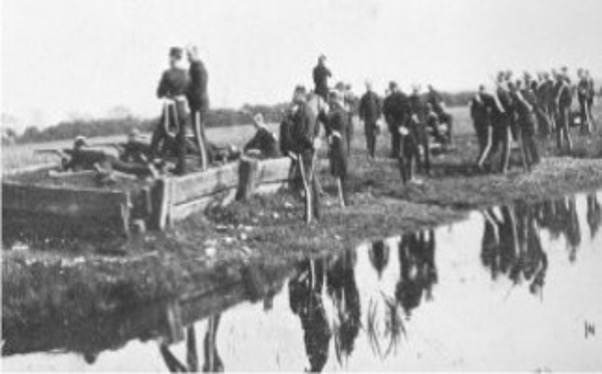
The picture shows Cheshire Dragoons firing on Sealand range in west Cheshire in 1898. The Lindow ranges may have had some similar rectangular firing points.
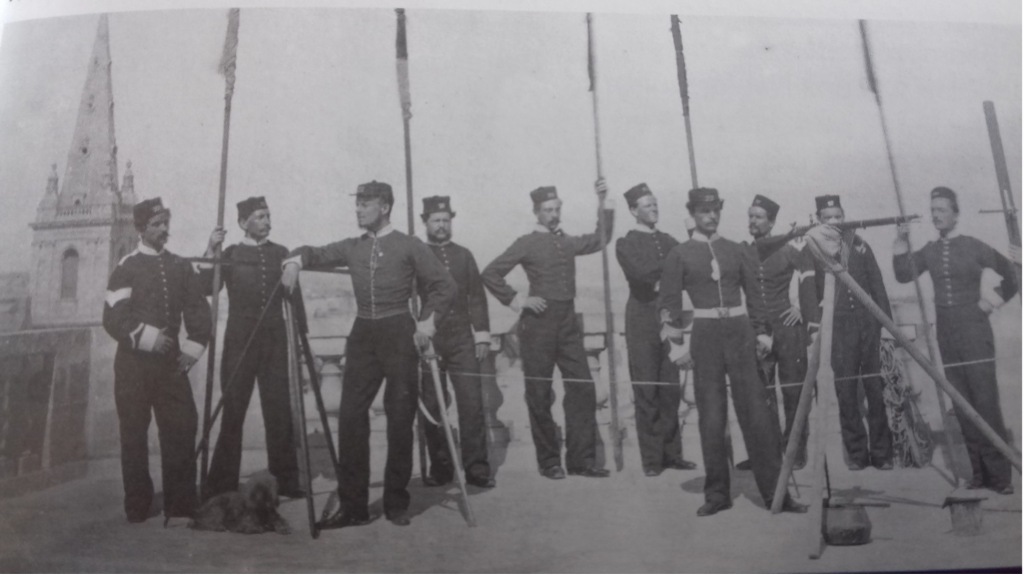
photos by kind permission the Cheshire Military Museum Chester.
This picture of 2nd Battalion Cheshire regulars musketry staff and dog was taken at Valleta in Malta in 1858 and shows signal flags, telescopes, a home-made rifle rest and pots of ‘whiting’ and ‘lamp black’, mixed with water and size, to refresh the faces of the iron targets smudged by bullet impacts. Flags allowed safe communication from the butts to the firing point to allow for adjustment of sights and correction of aim.
The Uniforms.
A range of uniforms were worn by different the Cheshire companies. The Birkenhead company wore grey tunics, the Wilmslow Corps wore dark grey and others wore scarlet or dark blue. The hats also varied over time from the policeman helmet style, a bucket shaped shako, a cap or a Glengarry. For the uniform in 1878 The 5th Battalion adopted a grey helmet for full-dress, fittings to be silver in place of bronze, with Prince of Wales Plume worn in the centre of the plate.
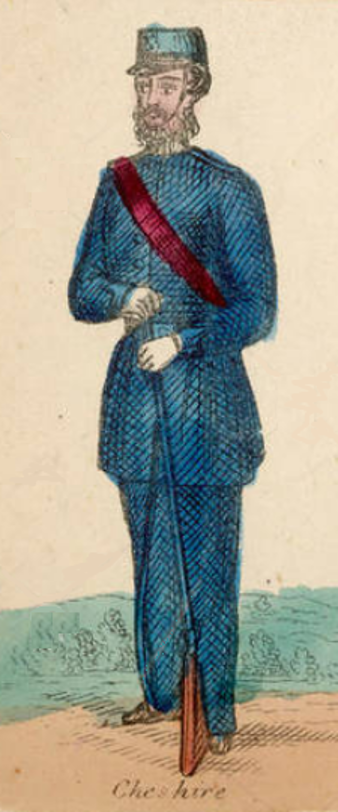
This illustration of a Cheshire Rifle Volunteer from Redington’s New Twelves of Rifle Volunteer Corps, “a coloured print of 12 different Rifle Volunteer figures.” Published by J. Redington of London, c.1860.


photos by kind permission of the Cheshire Military Museum Chester.
These pictures are of the 1st Cheshire Rifle volunteers from Birkenhead at a camp and lined up for a photo 1860. Most are wearing shakos of a type similar (though seemingly not the same) as the museum example below. Other companies had helmets.
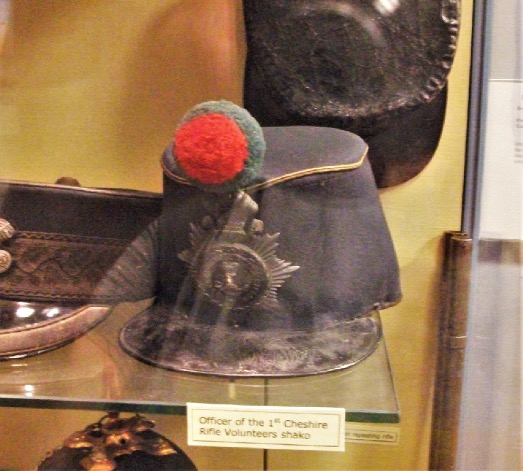
Shako of the 1st Cheshire RVC, c.1860.
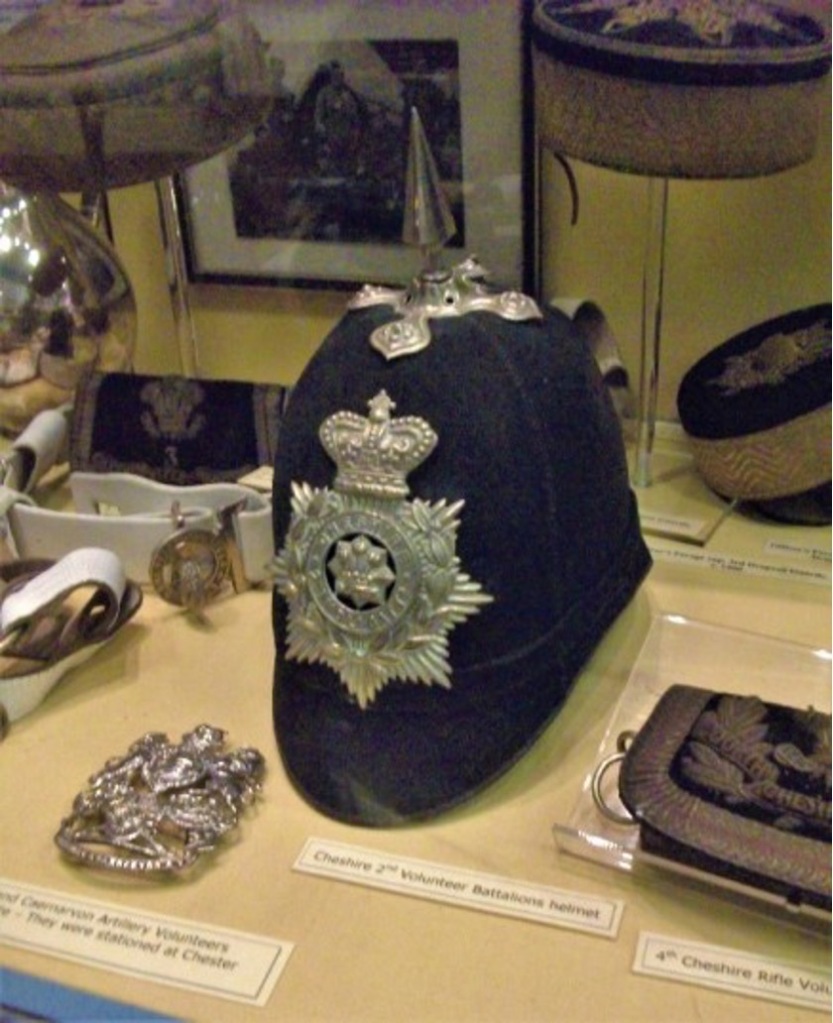
Above Shako of the 1st Cheshire RVC, c.1860, Below Helmet of the 2nd Cheshire RVC.
photos by kind permission of the Cheshire Military Museum Chester.
At the time of the Childers reforms of the army in 1881 the badge was the eight-pointed star with the Prince of Wales plumes. The headdress changed in 1898 the eight-point star remained but with an acorn and two leaves instead of the feathers.
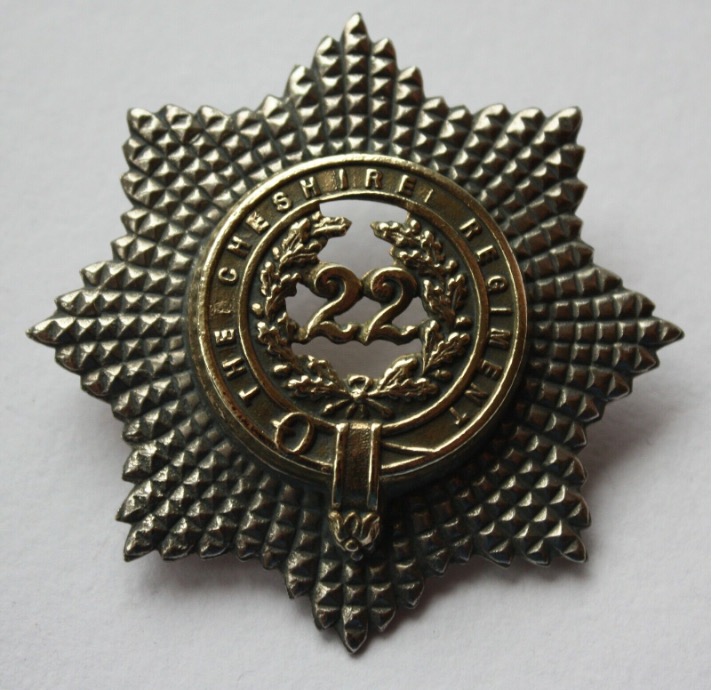
A 22nd foot cap badge.
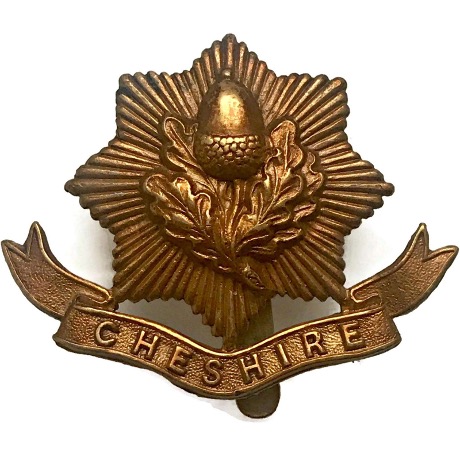
A 22nd foot cap badge (top). A Cheshire Regiment cap badge called the Economy type from 1916 (bottom).
The Rifles
In the 19th Century military technology developed a pace. Prior to 1853 muskets only had an effective range of about 200 yards.

A Brown Bess musket used from 1745 to beyond 1860.
In 1853 the Enfield rifle-musket was put into production, it saw extensive action in the Crimean War. It had a grooved barrel allowing the .577 bullet to spin making greater accuracy and producing greater effective distance but needing longer practice ranges. The bullet on firing expanded to fit the barrel and grip the grooves of the rifling and spin preventing the rapidly expanding gases in the barrel from escaping, by bypassing the bullet travelling up the bore.

The 1853 Pattern Enfield rifle – note the three metal bands on the barrel
Around the midpoint of the 19th Century, the benefits of breechloading were becoming obvious to all but the most entrenched military minds. A man with a converted rifled musket could fire 3 times faster than the muzzle loader. European armies began the arduous task of converting their vast stocks of muskets to breechloading arms. One of those conversions was Britain’s first breech-loader, the Snider rifle with this faster loading.
There are records of Cheshire Corps being equipped with Snider rifles in 1866 which the British Army had adopted in 1866 as a conversion system for its Pattern 1853 Enfield muzzle-loading rifles and used it until 1874 when the Martini–Henry rifle began to supersede it.

A Snider rifle

The Snider Cartridge for breech loading.
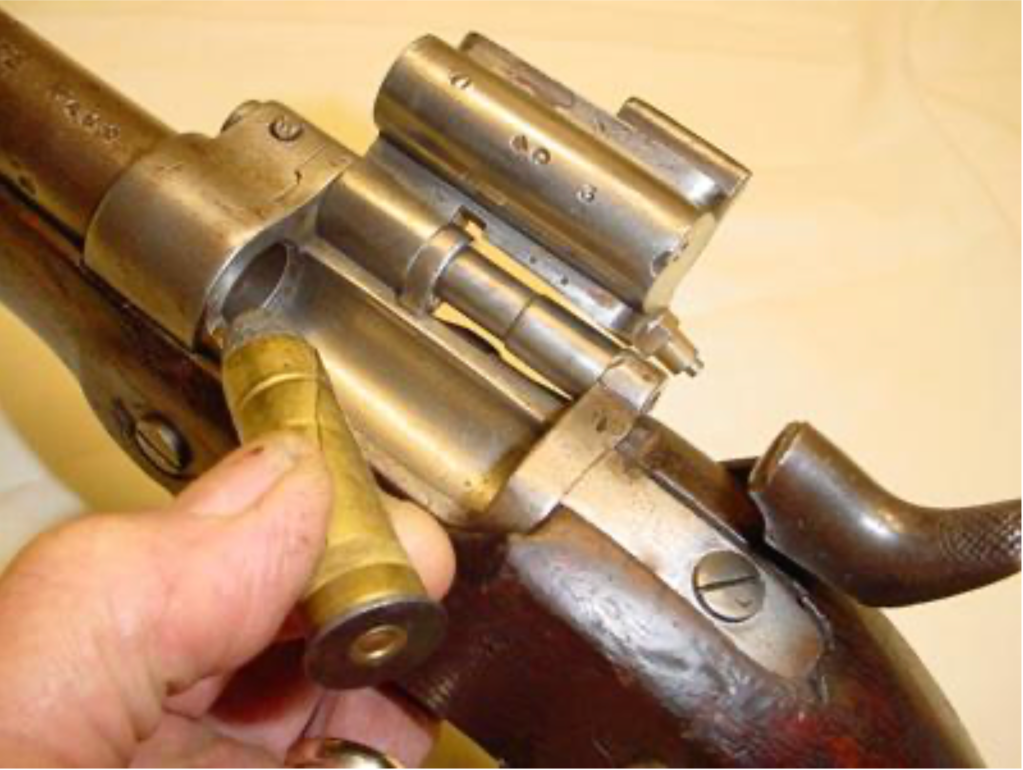
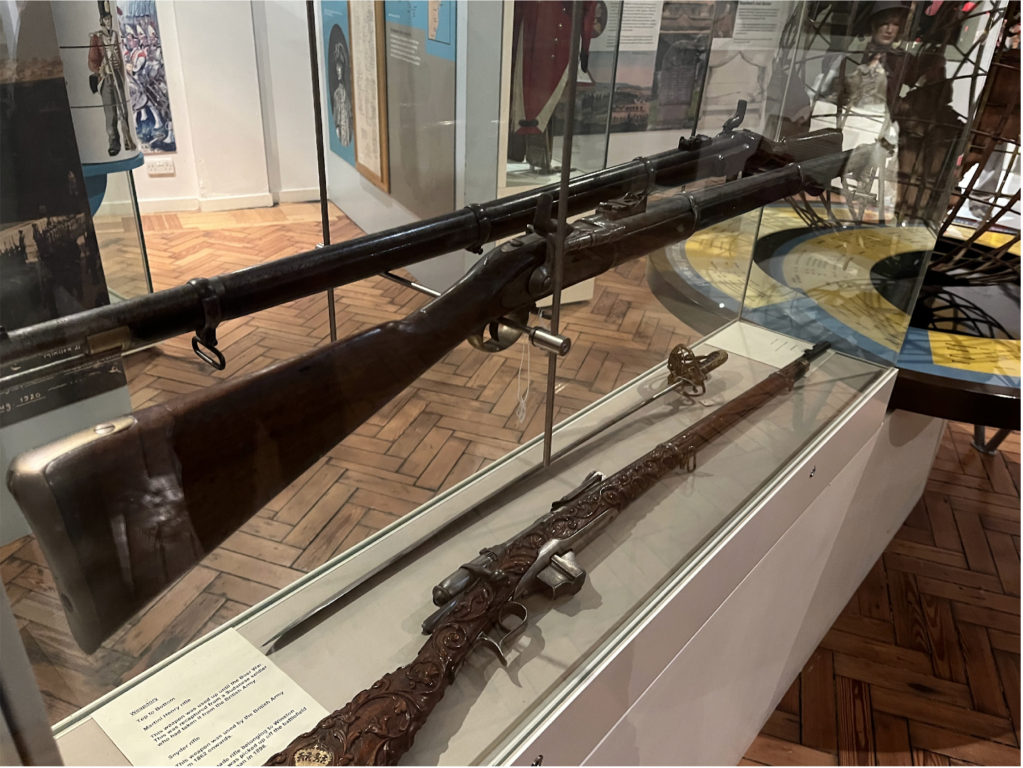
The 1853 pattern (far rifle) and the Snider variant nearest.
By Kind Permission of the Fusilier Museum, Bury.

A view of the adapted breech.
By kind permission of the Fusilier Museum, Bury.
The Martini-Henry rifle superseded the Snider and was issued to the Wilmslow Volunteers in 1885.
An article from the Alderley and Wilmslow Advertiser 23rd January 1885 records
“Martini-Henry rifles will be issued shortly, and the snider called in, men who are now in possession of the rifles must be prepared to bring them into store at short notice, clean and in good order- (Signed) Richard Cobbett, Capt. commanding detachment.

The Martini Henry Rifle as used at Rouke’s Drift.
In turn succeeding the Martini-Henry was the Lee-Metford issued to the British Army in 1888 but probably not getting to Wilmslow until up to ten years later.

The Lee-Metford mark 11 rifle.

Some examples from elsewhere. (From left to right), .577 Snider cartridge, a Zulu War–era rolled brass foil .577/450 Martini-Henry Cartridge, a later drawn brass .577/450 Martini–Henry cartridge and a .303 British Mk VII SAA Ball cartridge.
No bullets have yet been recovered from Lindow. As calibres and shapes changed in this period of rapidly changing technology any would help with dating.
Regular Service
Rifle volunteers were sufficiently motivated and enthused to volunteer for regular service. A report in 1878 reads “The critical state of affairs in the East at this time, and the probability of England being engaged in a great war, rendering it advisable to adopt every means of strengthening the hands of Her Majesty’s Government, Sir Charles Shakerley offered the services of his Battalion. Over 600 Officers and men volunteered for service abroad, the 33rd Corps giving their names almost to a man, and the 8th Corps furnishing 263 out of 400 enrolled members.”
Boer Wars
Britian lost the 1st Boer War (1880-81) which highlighted the need to modernise musketry training and review dressing fighting troops in scarlet.
Between 1899 and 1902, the British Army fought the second bitter colonial war against the Boers in South Africa. After initial setbacks and a long period of guerrilla warfare, the British eventually prevailed but not without adopting controversial and internationally condemned tactics against the civilian population. The 2nd Battalion Cheshire Regiment fought in the Boer War sailing on the Britannic in January 1900 forming part of 15th Brigade under Wavell. 376 officers and men returned home in October 1902.
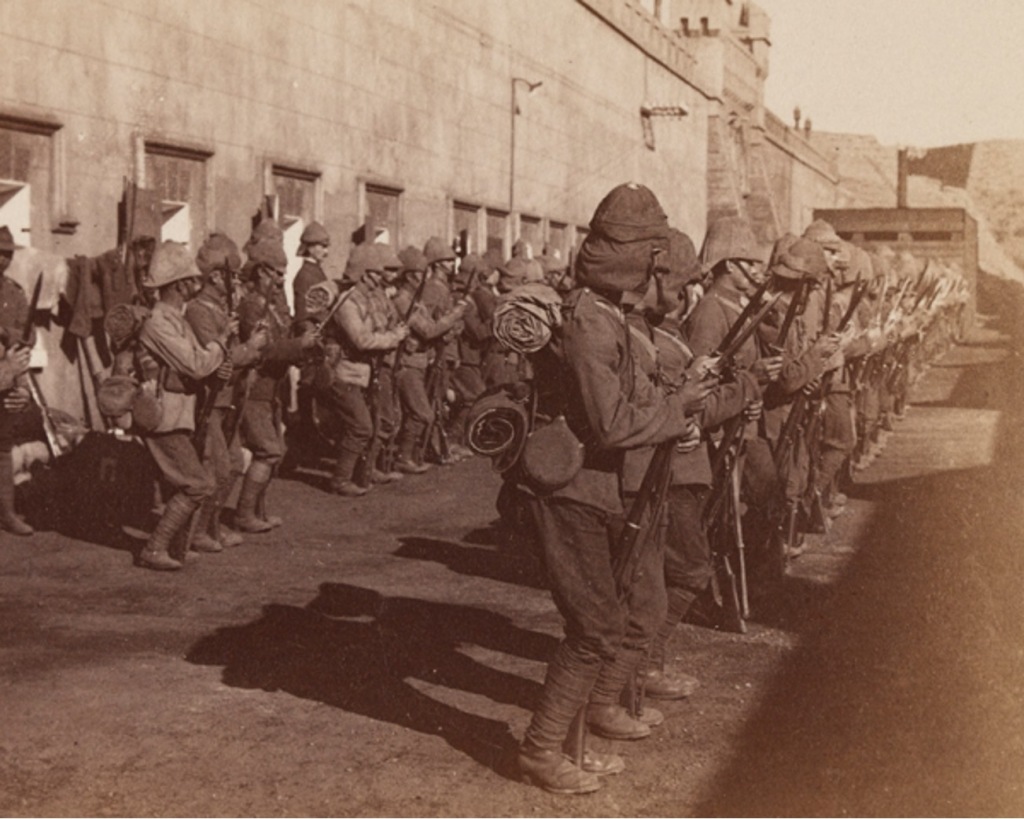
Inspection of 2nd Cheshire Regiment Regulars at Johannesburg, 1900
photo by kind permission of the Cheshire Military Museum Chester.
The Cheshire 3rd (Militia) battalion was also embodied for active duty in South Africa, with 450 men reported as returning home after the end of the war in September 1902.
War technology had moved on a pace in the 19th Century and as an example of this the Boer war troops used the .303 Lee-Metford Mark II Rifle still with black powder ammunition. This had replaced the Martini Henry rifle from 1888 with a rear locking bolt action and detachable magazine with a maximum range on 1,800 yards. Some years later it was itself replaced by the Lee-Enfield (Long Lee) .303 with smokeless powder ammunition.
The End of the Riflemen and the Range.
With the new rifle and bullet technology the distance of travel of bullets which lead to safety concerns. The Martini–Henry first entered service in 1871, eventually replacing the Snider–Enfield but the Volunteers have received it in 1885. The Lee-Metford rifles were probably issued to the volunteers in 1893.
Although no actual accidents were apparently recorded or reported from Lindow, there had nevertheless been concern and complaints. Following local grumbles, it is likely to have been examined by the District Inspector of Musketry and it was consequently condemned by the War Office as unsafe and closed down by 1895.
From thereon great efforts were made by the local Volunteers to have a new range constructed at Morley Green (see Appendix 6). Based on newspaper reports published at the time the campaign for a new continued for almost a decade
The Wilmslow Advertiser has correspondence in 1902 about Wilmslow Urban District Council moaning about the rifle range and the volunteers spending time in the public houses.
A petition was made the Secretary of State for War by Colonel Shakerley in 1902 on behalf of the riflemen. It claimed the Wilmslow company had a nominal establishment of 232 with two captains and 5 subalterns but an actual complement of 140. It claimed they had been unable to fire locally with the introduction of the new rifle since 1893 (possibly the Lee-Metford rifle). It said a new site had been found and called for the permission for a new 350 yards range and the hope of a new range would prevent disbandment.
Across the country the introduction of the .303” calibre magazine rifle with its jacketed bullets led to a new safety appraisal of existing rifle ranges and the rapid demise of iron target ranges. The new Lee Metford bullets were faster and flew further than the bullets of the previous Martini-Henry rifle, which had already caused some unease, as its bullets were harder than those the even earlier Enfield and Snider bullets. Jacketed bullets of .303” calibre have a greater tendency to ricochet or to behave more erratically when hitting a hard stony or metal surface. It is generally thought Martini-Henry’s muzzle velocity was c. 1300 feet per sec with bullet extreme reach about 3000 yards and for Lee Metford its was 2200 ft per sec and 3700 yards. As the Wilmslow Volunteers did not receive the Lee Metford until the new 1898 season commenced in 1898 Bill Flentje has concluded as Lindow range possibly closed actually about 1893 the immediate reason for its demise may be due to some other, perhaps safety reason. There had been many complaints and there were dwellings, gardens and roads close to the line of fire of the southern range.
An article in the Manchester Evening News of 17th June 1903 recorded “The Wilmslow Volunteer authorities have decided to adopt the new safety range patented by Colonel Ralston of Glasgow and a convenient site has been acquired on Lindow Common. It is expected the new range will be ready for use early next year.”
This idea was doomed from the beginning, as in 1903 the W.O. announced that the principle and design of such ranges had been found to be unsafe and such ranges therefore would no longer be constructed.
So this safety range was never built, there is a record the shooting was being done in Macclesfield (Advertiser 2nd January 1904.) The lack of progress with any range may have been due to opposition by Bucklow, Ringway and Styal Councils (Advertiser 30th July 1902)
The Iron targets universally used on rifle ranges until about 1898, would be condemned by the War Office from 1899 as ‘dangerous for markers’. Their replacement were metal mechanisms, known as ‘target frames’, which allowed canvas/paper targets to be stretched over wooden frames, to be raised and displayed above the mantlet. The new methods and systems of working, marking and signalling, considerably enhanced the speed and accuracy of the operation, and above all, its safety.
A find of a metal shoulder flash from the South Lancashire Regiment based in Warrington found west of Rotherwood Road suggested this area might have been used as a muster point.
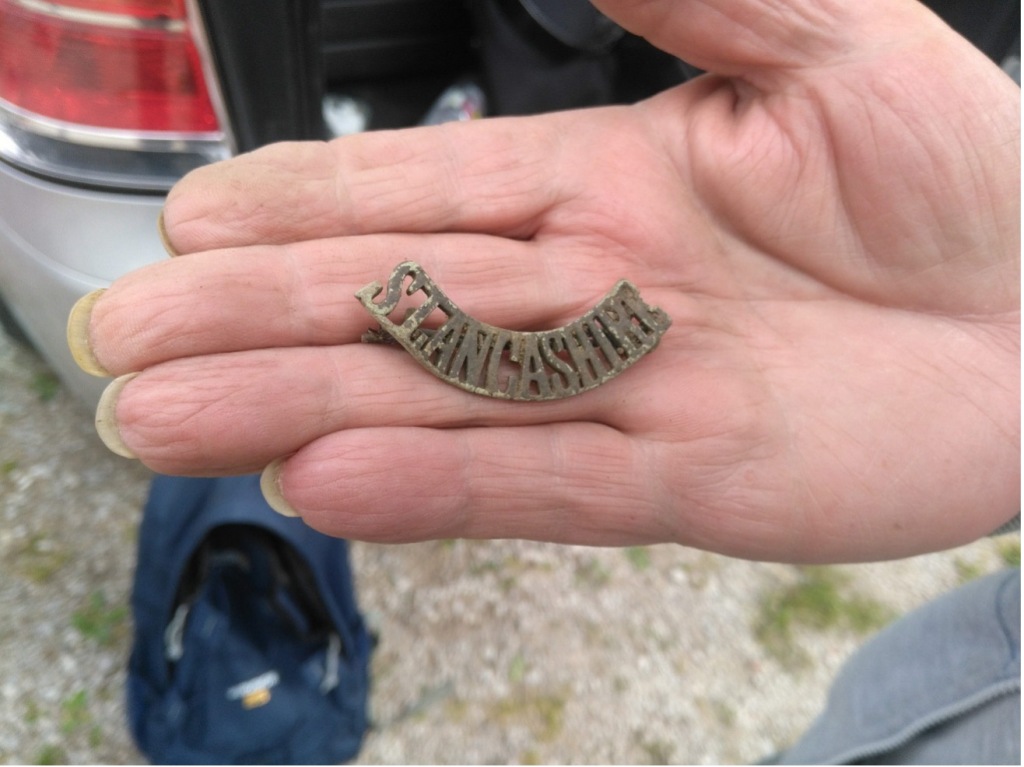
The Volunteer Rife Corps became part of the new territorial army under the Territory and Reserve Forces Act 1907.
Another newspaper article 26 August 1952 records “Volunteer Relic Includes the sale of lands at Wilmslow last night was the site of the old rifle range butts on the common at Wilmslow.”
This brought to an end to an almost one hundred years association with the rifleman in Lindow.
Our local connections
Though the Cheshire Regiment did not serve in the Crimean War the Battle of Alma River is commemorated in the name Alma Cottage and Alma Lane in Wilmslow both built soon after the battle.
The road across the Moss by the butts was named Battery Lane it now called Rotherwood Road.

The building appears on the 1876 map but not marked “PH”. By the time of the 1889 map, it is clearly marked “PH”. There is a local story that the rifles for the battalion were stored in the beer cellar here.
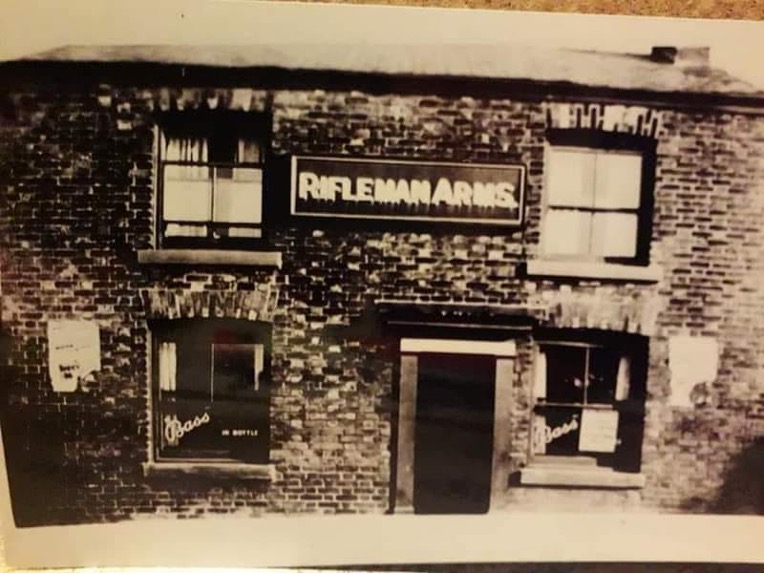
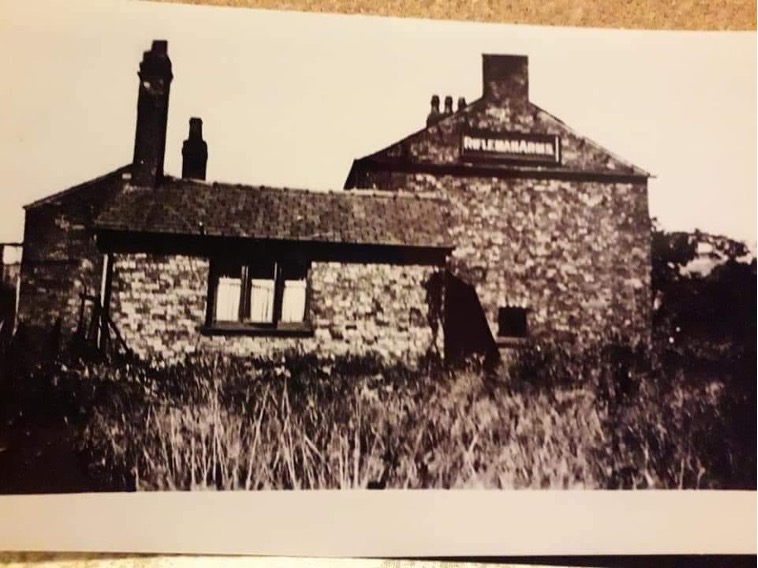
A new pub called the Riflemans Arms was then built next door in the 20th Century the original building demolished. This was in anticipation of Moor Lane becoming the main road to Knutsford and the design being similar to other roadhouses.
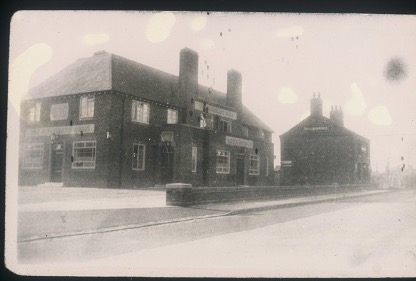
Pictured right, is the old pub, and left, the new pub.

The Riflemans Arms survived until 2017 when in turn it was demolished and houses built on the site. A new cul-de-sac called Riflemans Close on Moor Lane close by and opposite remembers the Wilmslow Rifle Volunteers and the pubs.
Conclusion and recommendations
- The 27th Company of volunteer rifleman of Wilmslow and Alderley Edge were formed in 1860 and practised on the two ranges on Lindow Moss east of the current Rotherwood Road.
- The rifleman would provide interesting material for an interpretation board and for activities for the Lindow Landscape Partnership which WHS supports.
- 2024 is the 40th anniversary of the finding of Lindow Man and events are planned for Lindow. The Historical Society is planning to participate in these and encourages our members to join in.
- Further research could be undertaken for instance for evidence of local public meetings, newspaper accounts and minutes of meeting of the 27th Company.
- Although a cursory initial search has not identified any structures above ground of the ranges it may be worth undertaking searches for any traces of the ranges including metal detecting and archaeological investigation for fired bullets and firing points.
With many thanks to the Cheshire Military Museum Chester, Paul Dalton of The Fusilier Museum in Bury, the National Trust Quarry Bank Mill Styal, Michael Gorman of the Historical Society, Peter and Julie for a site visit and for Ray Acton for their very kind assistance with this article.
Extra special thanks are due to Bill Flentje for his extensive research into range technology and practice and for his kind support.
Cllr Jon Kelly
Wilmslow Historical Society
25th March 2024.
Appendix 1 – extract of Volunteer Service Gazette 20 November 1875.


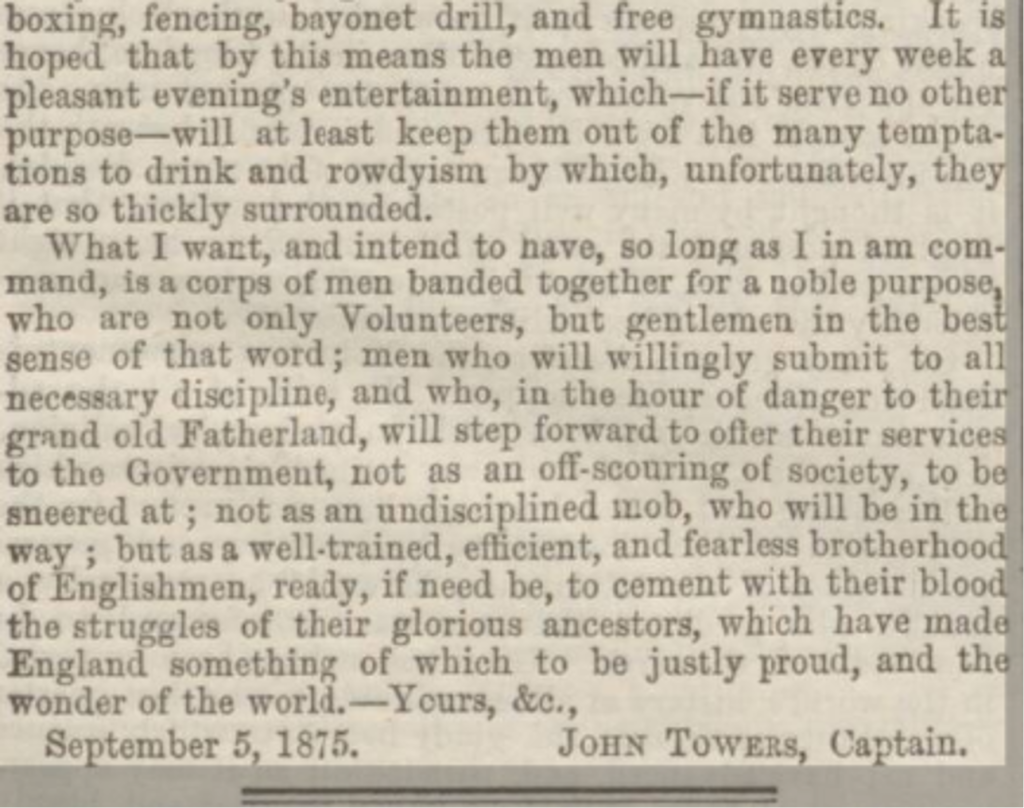
Appendix 2: The 5th administrative battalion
The following 6 corps became part of the 5th Administrative Battalion:
5th Cheshire (Congleton) Rifle Volunteer Corps in 1859
8th Cheshire (Macclesfield) R.V.C in 1860
16th Cheshire (Sandbach) R.V.C. in 1860
27th Cheshire (Wilmslow) R.V.C. in 1860
33rd Cheshire (Nantwich) R.V.C. in 1860
36th Cheshire (Crewe) R.V.C. in 1865 (disb. 1880)
Another East Cheshire town saw the formation of the 15th Cheshire (Knutsford) R.V.C., which, together with corps at Northwich, Winsford and others, the 15th was part of the 3rd Adm. Bat.
Appendix 3: Rifle characteristics
There are different opinions as to distances, for instance, some people believe the Enfield’s effective range was 800-1000.
Appendix 4: The firing process and Damage to the Butts by Bill Flentje
Firing sequence
Now, here is the sequence of events – the shooter takes aim and fires and after a second or two, he will hear the satisfying ‘clang’, when the bullet hits the iron target. In the meantime, the marker, standing in the safety of his shelter (mantlet), has been watching the target face (at a distance of about 16 yards). While he hears the ‘clang’, he witnesses a new grey lead ’smudge’ being created on the target face, when the bullet hits it and disintegrates. Only then he hears the sound of the rifle shot itself. He will grab the ‘pointer’ and use its ‘disc’ to indicate on the signalling panel (dummy target) the bullet’s impact point, while at the same time, in line with an agreed code (see below), he will indicate the value of the shot. On the firing point all this will be seen and a record of it made. And so it goes on, shot after shot, until the number of ‘smudges’ on the target make the identification of new ones impossible. At this point the marker will raise the red ‘cease fire’ flag above the mantlet. He waits until he hears the bugle call from the firing point telling him that that firing has stopped. He can now safely leave his shelter and approach the target with his pots of black and white paint, which he will use the ‘repair’/refresh the face of the target. That done, he will retreat back behind the mantlet, lower the red flag, and the show will go on.


Appendix 5: The Targets by Bill Flentje
Regulation Military (iron) Target Configuration for military practice, competitions, class-firing (2nd & 3rd Class only shown), used by Regular Army and Volunteers.


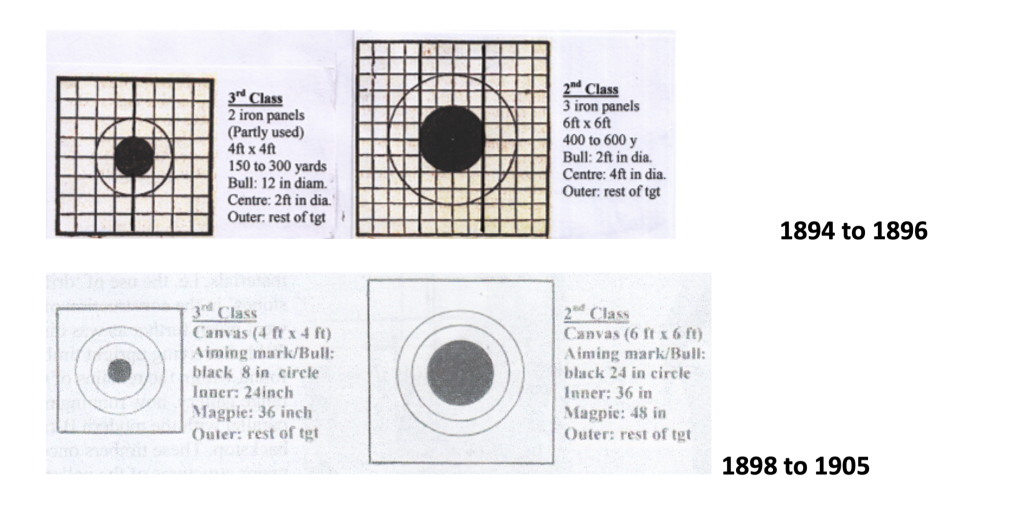
The above was the first pattern drawn up for canvas targets
Note: additional scoring ring.
Appendix 6: The Proposed Morley Range by Bill Flentje

In attempt to obtain a new range a site was sought in Morely. No maps were seen showing the intended alignment of the proposed range near Morley, but various clues published in newspapers at the time allow the above map to be drawn. Below some of the published ‘clues’:
‘…it is in the valley near the River Bollin and not far from Bollin House…’
‘…the site is between Oversley Bridge and Castle Mill, and the extent of ground required is
about 2200 yards long and from 50 -500 yards wide…’
‘…to purchase land starting just below Dooleys Lane…’
‘…the natural Butt, Hooksbank Wood, is of great height, and the shooting is downhill…’
‘…the targets would be at the base of Hooksbank Wood & only visible from the east…
‘…only one site approved by the authorities is the one at Oversley…’
‘The shooting range of the Wilmslow Volunteers has been condemned by the authorities as unsafe, and arrangements are now being made with a view to securing suitable ground at Morley belonging to Sir Humphrey de Trafford. The present shooting range is on Lindow Common, and this has been in the possession of the volunteers for nearly 40 years.’ [A.&W. A., 27.04.1895]

Extract of official 1903 ‘Return of Rifle Ranges
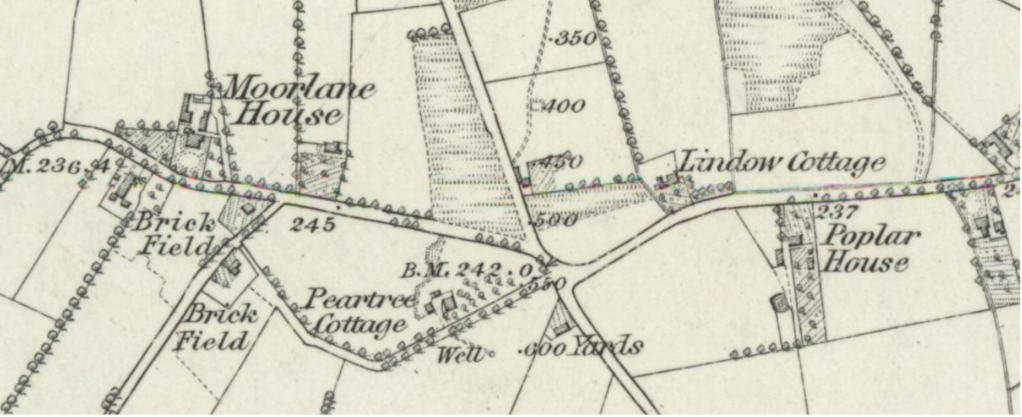
OS 6-in Cheshire 27, survey 1872, published 1882
Safety Concerns for the Lindow range.
At the old range there was an occupied house about 12 yards to the left, and another house about 30 yards to the right of the “line of fire”, both of these houses were about 110 yards in front of a much used firing point, while the main road ran right across the “line of fire” and about 60 yards in front of the main firing point.
Appendix 7 – The poem : Riflemen Form!
There is a sound of thunder afar,
Storm in the South that darkens the day!
Storm of battle and thunder of war!
Well if it do not roll our way.
Storm, Storm, Riflemen form!
Ready, be ready against the storm!
Riflemen, Riflemen, Riflemen form!
Be not deaf to the sound that warns,
Be not gull’d by a despot’s plea!
Are figs of thistles? or grapes of thorns?
How can a despot feel with the Free?
Form, Form, Riflemen Form!
Ready, be ready to meet the storm!
Riflemen, Riflemen, Riflemen form!
Let your reforms for a moment go!
Look to your butts, and take good aims!
Better a rotten borough or so
Than a rotten fleet and a city in flames!
Storm, Storm, Riflemen form!
Ready, be ready against the storm!
Riflemen, Riflemen, Riflemen form!
Form, be ready to do or die
Form in Freedom’s name and the Queen’s
True we have got–such a faithful ally
That only the Devil can tell what he means.
Form, Form, Riflemen Form
Ready, be ready to meet the storm!
Riflemen, Riflemen, Riflemen form!
Alfred Lord Tennyson
Appendix 8: Lindow Ranges Dates
| Date | Event | Yards |
| 1853 | Enfield rifle invented There are diverging views on the Absolute Maximum Effective Range’ (furthest distance travelling bullet still lethal but potential accuracy of the weapon used has no bearing. | 300 / 1250effective range/ maximum range |
| 1860 | 27th Wilmslow Corps formed 5th March 1860 | |
| 1861 | North and South Ranges constructed | |
| 1870 | Snider rifles issued to Wilmslow Corps | 600 / 2000 |
| 1872 | Map North range South range | 1000600 |
| 1871 | Martini Henri rifle issued to British Army | 400 / 1900 |
| 1878 | Battalion Rifle competition with Snider rifles | |
| 1885 | Martini-Henry issued to Wilmslow Volunteers | |
| 1887 | 5th Cheshire Rifle Volunteers redesigned as 5th Volunteer Battalion part of the Cheshire Regiment. Wilmslow is “H” company | |
| 1888 | Lee Metford first issued to British Army | |
| 1895 | Range lost | |
| 1898 | Lee Metford issued to Corps | 800 /1800 |
| 1902 | Petition submitted | |
| 1902 | Lee Enfield issued to Army (Long Lee) | 550 / 3000 |
| 1908 | Territorial incorporation7th Battalion Territorial Force |
Source Kelly/Flentje